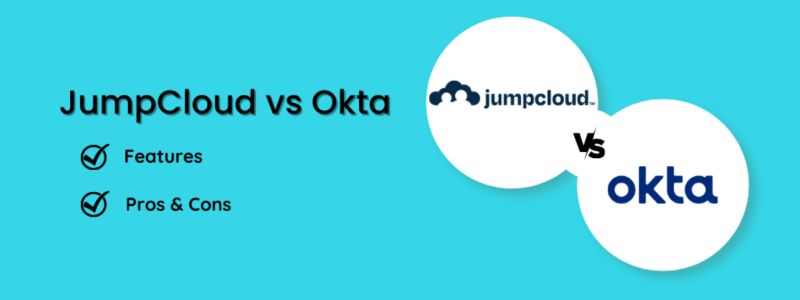In today's digital landscape, businesses require robust identity and access management solutions to protect their sensitive data and secure user access. JumpCloud vs Okta are two prominent players in the IAM space, offering a range of features and functionalities. In this article, we will conduct a thorough comparison of JumpCloud and Okta, exploring their key features, security offerings, and pricing structures. So, let's dive into the world of JumpCloud vs Okta and discover which solution is the right fit for your organization.
JumpCloud: Streamlined IAM for Modern Enterprises
JumpCloud is a cloud-based IAM platform designed to centralize user management, authentication, and device management across different platforms, applications, and networks. Its core offering revolves around Directory-as-a-Service (DaaS), which acts as a comprehensive directory service, connecting users to their resources securely. Here are some of JumpCloud's latest updates and features:
Jumpcloud’s Unified Endpoint Management (UEM)
JumpCloud has expanded its capabilities by introducing UEM functionality, allowing organizations to manage and secure their devices from a single console. This feature streamlines device onboarding, configuration, and security policy enforcement, enhancing overall device management efficiency.
Conditional Access Policies
With JumpCloud's conditional access policies, administrators can define rules and restrictions based on user attributes, device type, network location, and other contextual factors. This granular control ensures that users can only access resources based on predefined conditions, reducing the risk of unauthorized access.
Jumpcloud Just-in-Time (JIT) Provisioning
JumpCloud now supports JIT provisioning, enabling automated user provisioning and deprovisioning based on predefined triggers. This feature simplifies user lifecycle management, ensuring that users have the appropriate access privileges during their tenure with the organization.
Okta: Enterprise-Grade Identity and Access Management
Okta is a leading identity management platform that enables organizations to secure user access to applications, APIs, and other resources. It offers a wide range of IAM capabilities, including Single Sign-On (SSO), Multi-Factor Authentication (MFA), and API access management. Let's explore some of Okta's latest updates and features:
Okta Identity Engine
Okta has introduced the Okta Identity Engine, a set of customizable authentication and authorization workflows. This engine allows organizations to create dynamic, context-based access policies based on user attributes, device posture, and contextual signals. It provides greater flexibility in defining access controls tailored to specific business requirements.
Enhanced Threat Intelligence
Okta continuously enhances its threat intelligence capabilities to protect against emerging security threats. The platform leverages machine learning and behavioral analytics to detect and mitigate suspicious activities, ensuring a robust defense against unauthorized access and identity-related attacks.
Okta Devices
Okta Devices is a new feature that provides a unified view of all managed and unmanaged devices within an organization. It offers visibility into device health, security posture, and compliance status, enabling administrators to enforce access policies based on device trustworthiness.
JumpCloud vs Okta: Feature Comparison
Both JumpCloud and Okta provide comprehensive identity and access management solutions, but they differ in terms of their feature sets. JumpCloud offers a range of essential features, including user lifecycle management, single sign-on (SSO), multi-factor authentication (MFA), and directory services. Okta, on the other hand, boasts a broader feature portfolio, encompassing adaptive MFA, API access management, and advanced policy frameworks. When comparing JumpCloud vs Okta based on features, it's crucial to assess your organization's specific needs and determine which solution aligns better with your requirements.
Read More on: What is Single Sign-On? How Does SSO Work?
Security: JumpCloud Multi-Factor Authentication and Alternatives
One of the key considerations when evaluating IAM solutions is the strength of their security measures. Both JumpCloud and Okta prioritize security, but JumpCloud's multi-factor authentication (MFA) capabilities deserve special mention. JumpCloud MFA adds an extra layer of protection to user accounts, reducing the risk of unauthorized access. Additionally, JumpCloud provides a variety of MFA methods, including push notifications, TOTP, and WebAuthn, ensuring flexibility and ease of use. For organizations seeking alternatives to JumpCloud MFA, Okta offers robust MFA features as well, along with adaptive policies that dynamically adjust security requirements based on user behavior.
Know about Benefits of JumpCloud
Pricing: Comparing JumpCloud and Okta
Pricing is a crucial factor for organizations considering an IAM solution. JumpCloud and Okta have different pricing structures, making it essential to assess their offerings based on your organization's size and requirements. JumpCloud pricing model works with different tiers based on the feature set and level of support needed. Okta's pricing, on the other hand, is based on the number of user licenses and the desired feature package. It is recommended to evaluate the pricing plans of both solutions and assess their scalability to ensure a cost-effective choice that aligns with your organization's budget.
Conclusion
In the battle of JumpCloud and Okta, both solutions offer robust identity and access management capabilities. JumpCloud caters to organizations seeking essential IAM features, providing a strong emphasis on multi-factor authentication and ease of use. Okta, on the other hand, presents a comprehensive feature set, including adaptive MFA and advanced policy frameworks. When making a decision, consider your organization's specific needs, security requirements, and budget constraints. Evaluate the strengths and weaknesses of JumpCloud and Okta to determine which solution aligns better with your business objectives. Remember, investing in a reliable IAM solution is crucial for safeguarding your organization's data and ensuring secure access for users.
F60 Host is a Cloud Solutions Company helping clients realize the exact potential of the cloud to help their businesses grow.







